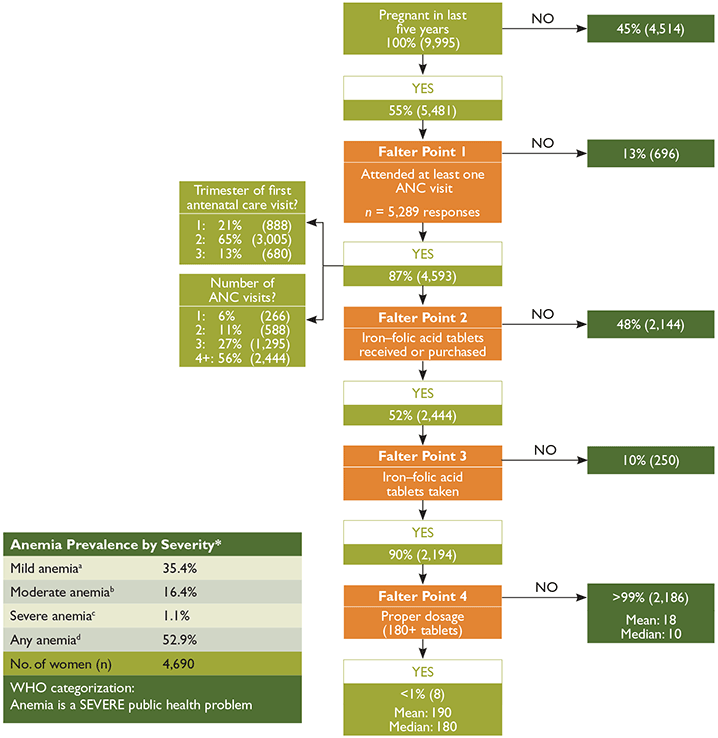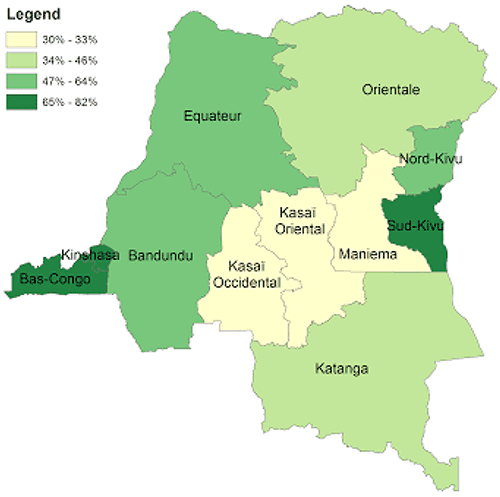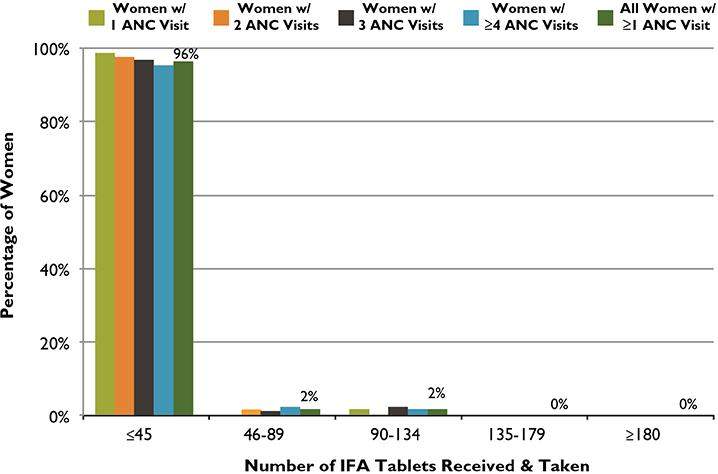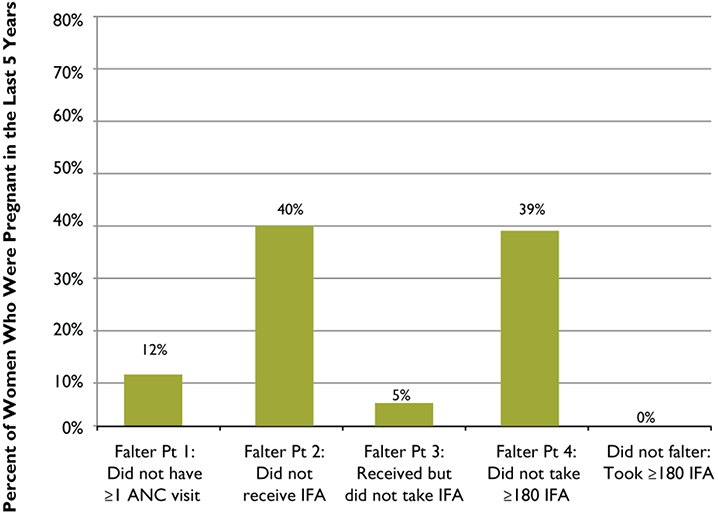Overview of the Global Anemia Problem, Including Iron Deficiency Anemia
The World Health Organization (WHO) defines anemia among women of childbearing age as the condition of having a hemoglobin concentration of < 12.0 g/dL at sea level; among pregnant women it is defined as < 11.0 g/dL. The hemoglobin concentration cutoff level that defines anemia varies by age, gender, physiological status, smoking status, and the altitude at which the assessed population lives.
The primary cause of anemia is iron deficiency, a condition caused by inadequate intake or low absorption of iron, the increased demands of repeated pregnancies—particularly if not well spaced (e.g., fewer than 36 months between pregnancies)—and loss of iron through menstruation. Other causes of anemia include vitamin deficiencies (such as a deficiency of folic acid or vitamin A), genetic disorders, malaria, parasitic infections, HIV, tuberculosis, common infections, and other inflammatory conditions. While iron deficiency anemia (IDA) accounts for about one-half of all anemia cases, it often coexists with these other causes.
Iron deficiency anemia is most common during pregnancy and in infancy, when physiological iron requirements are the highest and the amount of iron absorbed from the diet is not sufficient to meet many individuals’ requirements (Stoltzfus and Dreyfuss 1998). Anemia’s effects include increased risk of premature delivery, increased risk of maternal and child mortality, negative impacts on the cognitive and physical development of children, and reduced physical stamina and productivity of people of all ages (Horton and Ross 2003). Globally, IDA annually contributes to over 100,000 maternal deaths (22 percent of all maternal deaths) and over 600,000 perinatal deaths (Stoltzfus, Mullany, and Black 2004). Key anemia control interventions include promoting a diversified diet, iron-folic acid (IFA) supplementation during pregnancy, iron fortification of staple foods, prevention and treatment of malaria, use of insecticide-treated bed nets, helminth prevention and control, delayed cord clamping, and increased birth spacing.
Maternal Anemia in the Democratic Republic of Congo
The prevalence of anemia among pregnant women in the Democratic Republic of Congo (DRC) is 60 percent, making it a severe public health problem as defined by WHO standards1 (Ministère du Plan and Macro International 2008). In terms of anemia severity, the majority of cases among pregnant and breastfeeding or non-pregnant women reported in the 2007 DRC Demographic and Health Survey (DRC DHS) are classified as mild or moderate.2 Only 2.7 percent of anemia cases in pregnant women and less than one percent in breastfeeding or non-pregnant women are diagnosed as severe. The high rates of anemia in pregnant women may be further exacerbated by the prevalence of malaria. In the southeastern city of Lubumbashi, a clear relationship was found between malaria and anemia in pregnant and breastfeeding women: in two of three health clinics, the proportion of malaria cases was significantly higher in pregnant and breastfeeding women who were anemic than in those who were not (Kalenga et al. 2003). Additionally, the frequency of Ascaris, or hookworms, was higher in pregnant and breastfeeding women who were anemic than in those who were not in two of the three health clinic sites.
Falter Points in Women's Consumption of Iron-Folic Acid During Pregnancy
WHO recommends that all pregnant women receive a standard dose of 30–60 mg iron and 400 μg folic acid beginning as soon as possible during gestation (WHO 2012a). Ideally, women should receive iron-containing supplements no later than the first trimester of pregnancy, which means ideally taking 180 tablets before delivery. It is important to note, that many countries aim for women to receive 90 or more tablets during pregnancy.
Figure 1. Analysis of Falter Points Related to Distribution and Consumption of IFA through DRC’s ANC Program in 2007, Women of Reproductive Age (15–49 years) n = 9,995

Main Conclusions: ANC coverage is high, providing an outstanding platform for IFA distribution. Among women who were pregnant in the last five years, had at least one ANC visit, and took at least one IFA tablet, less than one percent received and took the ideal minimum number of tablets. Falter Point 4 is the most important, but Falter Point 2 is significant as well. Supply and demand are both likely constraints.
*Percentage of women 15–49 years based on Hemoglobin levels, Hb (g/dL)
aNPW 10.0≤Hb≤11.9, PW 10.0≤Hb≤10.9 b NPW 7.0≤Hb<9.9, PW 7.0≤Hb≤9.9 cNPW Hb<7.0, PW Hb<7.0 dNPW Hb<12.0, PW Hb<11.0
Non-responses, no data (NR/ND) were recoded to “No” for ‘“At least one ANC visit?”, “IFA tablets received?” and “IFA tablets taken?” and to zero for “Number of tablets taken?”.
Anemia prevalence data are provided as a reference point, signaling the general order of magnitude of the anemia public health problem. The ANC utilization data is based on self-reported data of women 15–49 years in permanent unions and pertains to their last pregnancy in the last five years prior to the DHS.
Source: Calculations and anemia levels are from the Democratic Republic of the Congo Demographic and Health Survey (2007).
Figure 1 shows a decision-tree analysis of how well the DRC’s antenatal care (ANC) system distributes IFA, and identifies four potential points at which the system might falter (highlighted in orange). The figure tracks the number and percentage of women who obtained ANC, those who subsequently received and consumed at least one IFA tablet, and those who consumed the ideal minimum number of tablets.3 All data are based on DRC DHS questions asked of women who were in permanent unions and had been pregnant in the five years prior to being interviewed4 (Ministère du Plan and Macro International 2008).
Many supply-side aspects—including both adequacy of IFA tablet supplies and technical knowledge and practices of ANC providers—need to be considered when assessing how well an ANC program delivers IFA. In addition, as Falter Point 4 in Figure 1 clearly shows, the provision of IFA tablets to a pregnant woman is a necessary but not sufficient condition for the woman to consume the tablets, particularly at the ideal minimum level. Thus, demand-side factors also play a critical role in determining the coverage and effectiveness of a program. These include whether or not women seek ANC and the timing and number of visits, as well as the extent to which women are aware of the significance of anemia and IFA, ask for IFA tablets, and comply with the IFA regimen.
Understanding the relative significance of each falter point makes it possible to prioritize them for more in-depth analysis, providing a first step in an evidence-based approach to systematically improving the program. The DHS does not collect information on the number of IFA tablets received by women. In the case of Falter Point 4, this lack of data creates ambiguities that make it impossible to fully understand whether shortcomings in the system relate primarily to supply- or demand-side factors. Despite this limitation, the decision-tree analysis presented in Figure 1 still enables prioritizing the falter points for more in-depth analysis and action at the national, district, and health center levels.
Analysis of Falter Points
Falter Point 1:
Did not attend at least one ANC visit
Only 13 percent of women did not have at least one ANC visit.
ANC’s relatively high coverage gives it great potential as a vehicle for providing IFA.
Falter Point 2:
Did not receive or purchase at least one IFA tablet
Of the women who had at least one ANC visit, 48 percent did not receive or purchase any IFA.
This supply-side constraint is quite substantial and may be due to various system/supply-side performance shortcomings, which could reflect: (1) inadequate supply (e.g., stockouts); (2) inadequate provider knowledge; or (3) inadequate provider practices, whereby adequate IFA is not provided. As Figure 1 shows, this and Falter Point 4 are the most important barriers to IFA distribution and consumption among all women in the DRC.
Unfortunately, the DRC DHS does not report the source(s) of the IFA tablets women received or purchased, and a small percentage of women attending ANC get IFA tablets from a different source. While only three percent of Congolese women who received or purchased IFA did not have any ANC visits (not shown), we cannot ascertain whether or not those who received ANC care obtained their IFA from their ANC provider. However, women who attend ANC may be more likely to be aware of, to value and also to also take IFA tablets, regardless of where they obtain them. Thus, we would expect a high correlation between the number of women who had at least one ANC visit and those who received or purchased IFA, which is consistent with the data. Women who had one or more ANC visits and who did not receive any IFA represent a missed opportunity to reduce the risk of anemia among a high-risk population.
Falter Point 3:
Did not take at least one IFA tablet
Of the women who received IFA, 10 percent did not consume any tablets.
This demand-side constraint is relatively small and may be due to women not understanding the significance of anemia and/or the significance of IFA. This misunderstanding may reflect: (1) inadequate provider counseling and follow-up; (2) women’s beliefs about actual or possible side effects; or (3) sociocultural factors.
Falter Point 4:
Did not consume 180 or more IFA tablets
Of the women who received and took IFA, more than 99 percent did not consume the ideal minimum of 180 tablets.
This is a combination of supply and/or demand-side factors. Figure 1 sheds some light on two possible causes of this falter point: 78 percent of women who received ANC began their care after the first trimester, and the 44 percent who had less than WHO’s recommended four ANC visits during their last pregnancy may have started their ANC too late or may not have had enough visits to receive 180 tablets (given IFA distribution protocols). Both of these are likely contributing factors, but further research is needed to establish their relative importance, as well as the significance of other possible causes. Globally, research has found that other common causes of Falter Point 4 include: (1) providers do not have access to adequate supply; (2) women do not receive adequate tablets because they have little access to care, or start ANC late, or do not have enough ANC visits making it difficult to obtain 180 tablets (given IFA distribution protocols); (3) providers do not provide adequate counseling or follow-up; (4) women do not adhere to the regimen; which may be due to difficulty in remembering to take the tablets daily, not knowing all the tablets are necessary, fear of having a big baby, side effects, tablet-related issues (taste, size, color, coating, packaging/storage problem). Further research is needed to determine the specific reasons for this falter point in the DRC.
Analysis by Sociodemographic Variables and Trends over Time
The DRC has achieved high levels of ANC coverage. It needs, however, to improve several other ANC performance measures. Less than one-half of women who have one or more visits, for example, obtain the WHO-recommended minimum of four visits, and less than one in five starts care in the first trimester. As Table 1 shows, there are large urban-rural differences in key ANC indicators, including coverage, the timing of the first visit, and the proportion of women who obtain four or more visits.
Table 1. Number and Timing of Antenatal Care Visits, DRC, 2007
| Indicator | Urban | Rural | Total |
|---|---|---|---|
| Number of ANC Visits | |||
| Month of First Visit | |||
| 0 | 7% | 16% | 12% |
| 1 | 4% | 6% | 5% |
| 2-3 | 34% | 31% | 32% |
| 4 + | 53% | 43% | 47% |
| Don't Know/No Data | 3% | 5% | 4% |
| No Antenatal Care | 7% | 16% | 12% |
| < 4 | 21% | 17% | 19% |
| 4-5 | 39% | 36% | 37% |
| 6-7 | 29% | 26% | 28% |
| 8 + | 2% | 3% | 3% |
| Don't Know/No Data | 1% | 3% | 2% |
Analysis by Geographic Region
The map in Figure 2 shows the percentage of women with at least one ANC visit who received at least one IFA tablet by region. The coverage rates vary by a factor of more than two, with the lowest rates in the central regions.
Figure 2. Percentage of Women Who Had at Least One ANC Visit and Received at Least One IFA Tablet by Province, DRC, 2007

The mean number of tablets taken throughout the country is very low; at most, less than one-fifth of the ideal minimum (not shown). Throughout most of the DRC, women are more likely to obtain their IFA tablets from a source other than ANC. While formative research is required to gain a better understanding of the specific causes of the shortcomings of IFA distribution through ANC in the DRC, and many diverse factors likely play a role in influencing IFA coverage, this analysis suggests that supply is a critical constraint.
Table 2. Prevalence of Anemia and ANC and IFA Coverage in DRC among Women 15–49 years, 2007
| Characteristic | Prevalence of Anemia | Did not Receive ANC* | Women with ANC Who Received at Least One IFA Tablet* | All Women with a Live Birth Past 5 Years | |
|---|---|---|---|---|---|
| Took 1 + IFA | Took 90 + IFA | ||||
| Province | |||||
| Bandundu | 64% | 12% | 48% | 49% | 0% |
| Kinshasa | 63% | 4% | 79% | 73% | 8% |
| Equateur | 57% | 13% | 51% | 46% | 1% |
| Bas-Congo | 56% | 4% | 69% | 63% | 4% |
| Maniema | 51% | 18% | 25% | 23% | 0% |
| Kasai Oriental | 50% | 14% | 29% | 22% | 1% |
| Orientale | 49% | 21% | 38% | 32% | 1% |
| Kasai Occidental | 48% | 8% | 28% | 24% | 1% |
| Katanga | 40% | 14% | 38% | 30% | 0% |
| Sud-Kivu | 39% | 13% | 64% | 61% | 0% |
| Nord-Kivu | 34% | 4% | 62% | 53% | 0% |
| National Average | 53% | 12% | 46% | 41% | 2% |
Note: The 2007 DRC DHS used a 90-plus IFA upper limit.
Table 2 shows the prevalence of anemia as well as coverage indicators for ANC and IFA by province. Anemia is widespread throughout the country, and constitutes a severe public health problem (as indicated by prevalence rates above 40 percent) in nine of the DRC’s 11 provinces—all but Sud-Kivu and Nord-Kivu. The percentage of women who had a live birth in the past five years and did not have ANC during their last pregnancy exceeds the national average by 75 percent in Orientale and 50 percent in Maniema. Not only was ANC coverage the lowest in these two provinces, but they are also among the provinces with the lowest percentages of women receiving ANC who received at least one IFA tablet and lowest percentages of women who received and took at least one IFA tablet during their last pregnancy. Skilled providers also account for some of the smallest proportions of ANC coverage in the two provinces (not shown). Access to care in general appears to be problematic in Orientale and Maniema.
Analysis by Number of ANC Visits
Figure 3 shows the relationship between the number of IFA tablets taken and the number of ANC visits women had during their last pregnancy (those who had at least one ANC visit). Among those who had at least one ANC visit, 96 percent took at most one-quarter (45) of the ideal number of IFA tablets. Women who had more visits were not likely to receive and take more IFA tablets. Among women who had four or more visits, less than one percent took at most only one-quarter of the ideal minimum.
Figure 3. ANC Distribution of IFA Tablets: Number of Tablets Received and Taken According to Number of ANC Visits, DRC, 2007

Overall Conclusions and Recommendations
Figure 4 presents the obstacles among all women— including those who did not receive ANC during their pregnancy—to taking the ideal minimum number of IFA tablets. In the DRC, Falter Points 2 and 4 are the greatest barriers. Improving the delivery of IFA supplementation to increase the proportion of pregnant women taking a minimum of 180 IFA tablets in the DRC will require identifying and addressing program gaps in IFA supply management and health workers’ practices (to improve performance at Falter Points 2 and 4), and modifying some women’s long-term adherence behaviors (addressing Falter Point 4), as well as addressing other points mentioned above in “Analysis of Falter Points.”
Figure 4. Relative Importance of Each of the Falter Points in the DRC: Why Women Who Were Pregnant in the Last Five Years Failed to Take the Ideal Minimum of 180 IFA Tablets

While the DRC’s coverage rate of ANC is relatively high (88 percent), less than one-half of the women (46 percent) who had a live birth in the past five years and had one or more ANC visits during their last pregnancy received at least one IFA tablet (Table 2). Moreover, among all women who had a live birth in the past five years, an even smaller share, 41 percent, took one or more IFA tablets during their last pregnancy, and only two percent took 90-plus IFA tablets, just one-half of the ideal minimum. Clearly, ANC in the DRC has enormous potential for improving the distribution of IFA and helping to reduce anemia, but many aspects of the program could be improved.
The DRC has made progress in reducing its maternal mortality rate (MMR)—from 660 maternal deaths per 100,000 live births in 2005 to 540 in 2010. Its MMR, however, continues to rank 165th out of 181 countries (WHO 2012b). This rapid assessment of the distribution of IFA tablets through the DRC’s ANC program suggests that there is much room for improvement in both the supply and the demand sides of the program. Improving the distribution of IFA through the ANC program is an important strategy for preventing and controlling anemia in the DRC, and for improving the nutrition and health status as well as the mental and physical capacity of women of reproductive age.
Footnotes
1 WHO categorizes anemia’s severity as a public health problem according to the condition’s prevalence: < 5 percent, no public health problem; 5–19.9 percent, mild; 20–39.9 percent, moderate; ≥ 40 percent, severe.
2 The DHS hemoglobin levels used to diagnose the severity of anemia in non-pregnant women differ from those specified by WHO. The DHS cutoffs for pregnant (P) and non-pregnant (NP) women in hemoglobin g/ dL are mild, 10.0–10.9 (P), 10.0–11.9 (NP); moderate, 7.0–9.9 (P), 7.0–9.9 (NP); severe < 7.0 (P), < 7.0 (NP); any < 11.0 (P) < 12.0 (NP)
3 The DRC DHS asked about IFA tablets or capsules; this brief refers to all forms as “tablets.”
4 The DRC DHS provides a population-based, nationally representative sample of all women in the DRC.